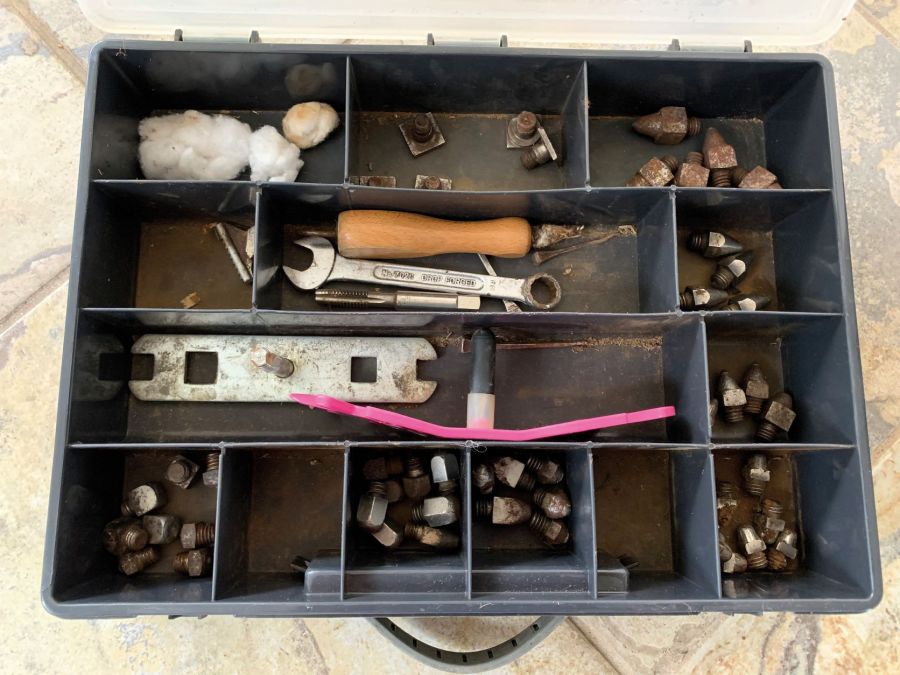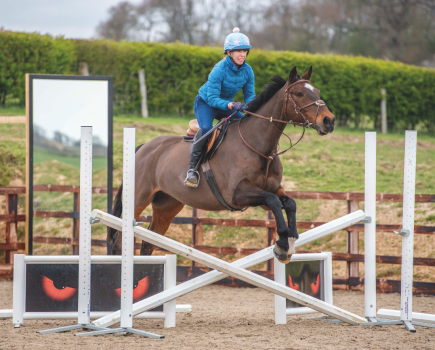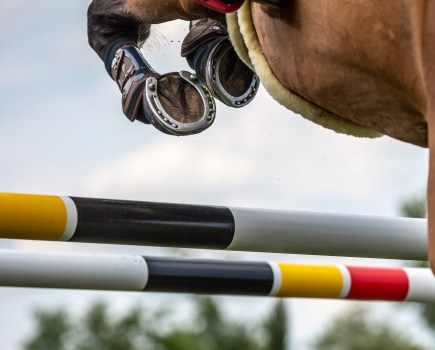If you’re planning to jump your horse on grass, you’re going to need holes in your horse’s shoes so that you can use studs. Studs provide better grip on the ground and are useful for any training or competing you do on grass, including flatwork, showjumping and cross-country. You can also get road studs, which give improved grip when hacking on slippery tarmac.
Every competitive rider should have a stud kit in their grooming box and needs to know which size studs to use and when. You may choose to use one in each horse shoe or two, and the studs come in all shapes and sizes. Which ones you use and when depends on the ground conditions, what activity you are doing with your horse and how much extra grip your horse requires with the ground.
What are horse shoe studs?
Traditionally, studs are small pieces of metal that screw into a horse shoe. However, it is now possible to buy studs made of plastic and other modern materials, which are thought to be easier to fit and potentially safer, as well as simpler to look after because they don’t rust. By improving a horse’s grip on the ground, it can give them more confidence in soft and/or slippery going, especially when travelling at speed and going around corners. If you’ve ever ridden a horse across country after it’s rained and you haven’t had studs in, you’ll have felt them quickly lose confidence as their feet slip from underneath them.
Your farrier will add holes for studs to a horse shoe before they fix it to the hoof. For older style of studs, they will also thread the hole. Your job is then to keep the hole clean (putting cotton wool or stud hole plugs in when no studs are being used will help with this) so that studs will easily and quickly screw in when you need them.
One stud or two?
You can choose to have one stud in each horse shoe or two. If choosing one, it is normal practice for this to be on the outside of the shoe. A second stud hole can be added to the inside of the horse shoe. The holes will be level with each other, towards the back of the shoe (ie away from the toe clip). Some riders prefer two studs, because it gives better grip and reduces how much the hoof can move when it hits the ground. Other riders choose one stud because of concern over restricting the hoof from moving as it naturally would. There is a school of thought that using a single stud on the outside of the hoof reduces strain on the leg’s structures when making a tight turn. However, most farriers recommend two stud holes in all four horse shoes these days to maintain medial lateral foot balance.
Personally, I like to use two studs in all four horse shoes. This has always worked well for my horses. I like the increased grip behind. I once watched my sister’s horse sit on his bum in front of a showjump when competing on slippery ground and fall over backwards (they were both OK). If he’d had two studs in both hind hooves, I think he would have had enough grip to stay on his feet.
Basically, how many studs you use comes down to personal preference. What works for one horse won’t work for others. We had one excitable ex-racehorse on our yard who punctured a hind fetlock with a stud when fidgeting while being counted down in the start box, and also while cross-country schooling. A joint penetration injury is a real worry — especially when caused by something as dirty as a stud — and each time prompted a hefty vets bill. Said horse never wore studs after that. We were picky about the ground he was ridden on instead.
What size stud should be used when?
There are all sorts of stud shapes and sizes and each design is best suited to different ground conditions.
“For firm summer ground, small pointed studs or road studs in front and larger pointed ones behind are best,” says Tricia Price, a UKCC Level 3 eventing coach who has ridden round both Badminton and Burghley on a home-produced horse. “Smaller studs in front avoid unnecessary jarring on the horse’s front legs as the balance of the foot is altered as it hits the ground at a different angle. Larger studs are used behind as there is not the same impact as on the front feet, so they can be used to help prevent slipping.”
The general rule is that the wetter the ground, the larger the stud you use needs to be. This is because studs with a bigger surface area give increased grip when the horse pushes off the ground. Look for dome, bullet, polo and large conical studs when you are riding on wet, muddy ground.
When you are riding on firmer ground, choose sharp, pointed studs, such as small dressage studs (which, contrary to their name, can be used for jumping as well) and small conical studs.
What are road nails?
I ride my horse on smooth roads in Oxfordshire, which are horribly slippery. My farrier puts tungsten tipped nails in all four hooves, which protrude about 1mm and improves grip considerably. These are commonly referred to as ‘road nails’ and they should always be used in all four hooves or in pairs (ie both fore feet or both hinds), as this maintains medial lateral balance of the horse’s hooves and limbs.
Road nails mostly solve the issue of slipping on roads for my horse, so are worth considering if you have this problem too. You may find road nails give improved grip on other types of going too.
What should a horse shoe stud kit contain?
A basic stud kit can start from as little as £25 and will contain a spanner or tap, a tool to clean out stud holes, plugs or cotton wool to fill stud holes when not being used and a selection of studs to choose from. A magnetic pot is useful for putting studs into once they are removed, as it lowers the risk of them falling out and getting lost.
“At the very least, a stud kit normally contains four road studs. These are small, shallow studs that can be square or hexagonal in shape and are used to give a horse extra grip on good ground,” says Tricia. “There will also be a selection of eight pointed and square studs. You can then add more types of studs to this to build your kit. A comprehensive kit will include a range of studs for using on hard or wet ground, and everything in between.
“In addition, I have a very useful magnetic stud bowl and I use a safety stud tap. A traditional stud tap has a spanner at one end, while the other end is used for screwing the empty stud hole before putting in the stud. The safety stud tap, however, has a shallow, round shape as opposed to a spanner which, if a horse fidgets and stands on the tap, means they are less likely to injure themselves.
“My kit also contains an adjustable spanner and either cotton wool or plastic plugs for packing the holes. Keeping stud holes clean and ready use, saves a lot of time on competition day.”









